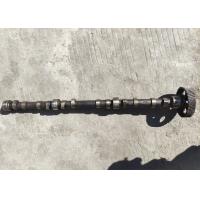C13 Used Camshaft For Excavator E349D E349F 224 - 1275 Electric
Specification
| Item name | Engine Camshaft |
| Geer quantity | 100 |
| Application | Engineering Machinery Engine |
| Camshaft code | 224 - 1275 |
| Geer number | 224 - 3247 |
| Engine type | Diesel |
| Injection | Electric injection |
| Size | Standard |
Description
How does Camshaft work?
The main objective of the camshaft is to open the suction valve and
exhaust valve at the appropriate time. The crankshaft drives to
this shaft. It is linked with the crankshaft through a belt or
meshing gears.
The movement of the camshaft is slower than the crankshaft. It
completes one revolution after two revolutions of the crankshaft.
In a four-stroke engine, a camshaft works in the following way:
As the piston moves from TDC to BDC (downward), it transfers its
motion to the crankshaft.
The crank receives piston motion and transforms this motion into
rotary motion, and starts rotating.
The crankshaft is connected with the camshaft through gear or belt.
As the crankshaft transfers its rotary motion to the camshaft, the
camshaft converts this rotary motion into reciprocating motion and
presses the inlet valve and opens it.
As the valve opens, the fuel starts to enter the combustion
chamber.
After suction and compression strokes, the combusted air-fuel
mixture expands in the chamber, which forces the piston to move
downward.
During the downward motion of the piston, again, the crankshaft
receives motion and moves the camshaft.
As the cam of the exhaust valve receives this motion, it presses
the exhaust valve and opens it, which allows exhaust gases to move
out of the combustion chamber.
Camshaft Construction Material
The solid material is most commonly used for the manufacturing of
the camshaft. This is because such camshafts provide great
rigidity. Cast iron is also used for the manufacturing of camshafts
because cast iron delivers more strength.
The camshafts made of the chilled iron process can provide
excellent wear resistance because the chilling method hardens the
material. Different materials mix with iron to generate the most
appropriate features for their applications.
Some industries also utilize billets when less production and
excellent quality are needed. But this process demands high time
and cost compared to other processes. These shafts manufacture
through machining, casting or forging on milling and lathe
machines. They are manufactured by forging, casting and machined on
lathes and milling machines.














